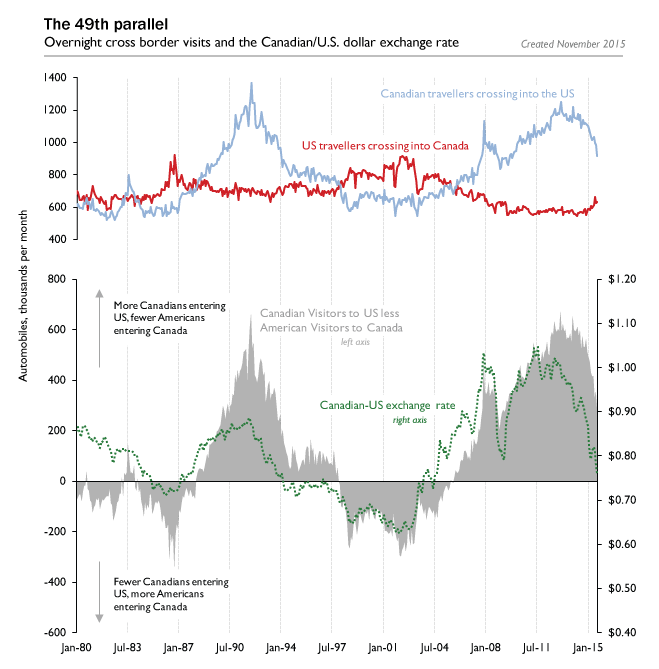Thanks to a floating exchange rate and one of the longest undefended frontiers in the world, the U.S.-Canada border is the thoroughfare for what may be one of the world's most popular ongoing consumer arbitrages.
Canada and the U.S. interlist all sorts of goods, services and financial assets. We both sell McDonald's hamburgers, we both offer tickets to NHL games, and we both list Valeant Pharmaceutical shares. The relative price of Valeant shares, which trade in New York and Toronto, will rapidly adjust to any change in the exchange rate. If not, then upon an appreciation of the U.S. dollar an investor will be able sell Valeant short in New York at an artificially high price, buy Canadian dollars with the proceeds, and acquire shares in Toronto on the cheap, using those shares to cover the short position in New York at a profit. Exploitation of this opportunity will realign Valeant's New York and Toronto share price until the window closes, thus cannibalizing the potential for arbitrage gains. This process takes seconds.
Financial prices are set "immorally." In the moral economy of Main Street, goods and services prices stay fixed for long periods of time. At time = 0, say that Big Macs and hockey tickets have the same real price in the U.S. and Canada so that people have no reason to prefer shopping in one country or the other. The moment that the Canadian dollar appreciates, a consumer arbitrage window opens that allows Canadians a chance to boost their welfare. Since sticker prices in the U.S. don't change, Canadians can now cross the border and buy more Big Macs and hockey tickets than they could if they had stayed parked in Canada. So much for the law of one price. This window will stay open for quite some time. Bils and Klenow (pdf), for instance, report that lunch menu prices in the U.S. only change once every 10.6 months while sporting event admission prices only adjust once every 3.9 months. (That's almost eleven months of free lunches.)
The chart below, which uses data from the Canadian Border Services Agency, illustrates how North American migration patterns fluctuate as the arbitrage window switches in favor of either the U.S. or Canada.
As the chart shows, the difference between Canadians visiting the U.S. and Americans visiting Canada (the green dotted line) is correlated to movements in the exchange rate. A weak loonie in the early 1980s and 1992-2002 encouraged more Americans to visit Canada while decimating the hoards of snowbirds headed south. The strong Canadian dollar from 1986-1992 and 2002-2011 did the opposite, stifling American visits while inspiring Canadian exits. The loonie's plunge over the last twelve months, aggravated by the collapse in crude oil prices, has finally begun to bring increasing amounts of Americans over the border for the first time in over a decade.
Going forward, expect to see more stories like this ("explosive growth" in Alberta ski hill bookings for this winter), this (Montreal sees best tourism season in years), this (Thunder Bay's tourism picks up) and this (bad news for Buffalo's airport).
Or course, you can't get something for nothing forever. Prices are rationing devices. When a good's price is fixed at an artificially low level then costly lineups will develop, substituting for price signals as a rationing device. The sudden undervaluation of goods & services on either side of the 49th parallel as the exchange rate fluctuates should give rise to congestion at the border, modulating the size of the consumer arbitrage window.
By the way, the chart above illustrates one of the advantages of having a floating exchange rate. Without a collapse in the loonie, price ratios between the U.S. and Canada would have remained much more rigid over the last twelve months, preventing the emergence of a consumer arbitrage opportunity in favour of American consumers. Canadian aggregate demand, already depressed by weakness in the energy sector, wouldn't be benefiting from an influx of American shoppers and returning Canadians. Unemployed oil workers in Fort McMurray wouldn't be getting the opportunity to find work on Banff's booming ski hills.


Comments
Post a Comment